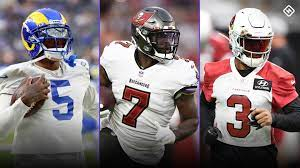How many players can be eligible receivers in football?

The National Football League or NFL is a professional American football league in the U.S. For a long time, NFL rules dictated that wide receivers - a forward pass-catching specialist - wear uniform numbers between 80 to 89. The league changed this restriction in 2004 and since then many pass-catchers have preferred lower jersey numbers.
Perception of size
In 2019, ESPN looked at possible reasons as to why so many wide receivers preferred to wear lower jersey numbers. The story stated that many athletes picked these numbers as they believed it made them look faster and slimmer. A professor of psychology and neuroscience who was quoted in the story offered a psychological explanation for this phenomenon, but clarified that there was no scientific research on the subject.
That has changed now with a new University of California, Los Angeles study published in the journal PLOS ONE in September revealing certain insights. Subjects in the study, which included two experiments, consistently rated images with players in jerseys numbered 10 to 19 as thinner than those in jerseys numbered 80 to 89, even for body sizes that were actually the same.
For their study, the researchers showed respondents computer-generated images of players in the same pose, but different body sizes, skin and jersey colours, and asked to judge slenderness. Each player was seen twice by the subjects, but with different jersey numbers - one high and one low. Regardless of the different factors, players in smaller jersey numbers were perceived as thinner than those wearing bigger jersey numbers.
Learned associations
In a second experiment, the researchers repeated the process in person. To address concerns that the amount of jersey space occupied by numbers from 80 to 89 (since 8 is wider than 1) could make players look larger, they chose number combinations that used the same numerals, but in different orders: 17 and 71, 18 and 81, 19 and 91. In this experiment too, subjects continued to perceive those with lower jersey numbers as being more slender, even though the effect was smaller than in the first experiment.
This study thus suggests that previously learned statistical associations between numbers and sizes influence even the perception of body size. In our everyday lives, we are used to seeing bigger numbers on bigger versions of similar types of objects. These learned associations usually help our brains thrive, enhancing the chances of survival.
While how viewers perceive the body size of American football players will have minimal effect on their performance, such biases might be harmful in other walks of life - be it when it influences judgement or when behaviour towards certain social groups is affected, a phenomenon known as implicit bias. Being aware might help us reduce implicit bias.
Picture Credit: Google